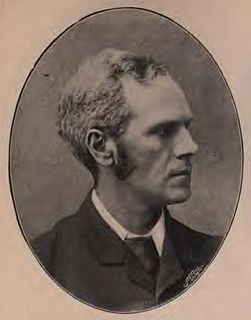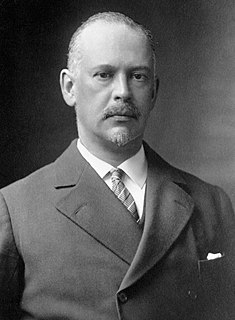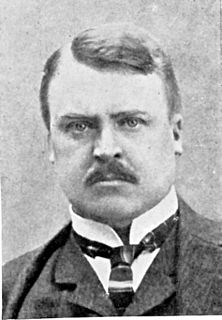This article does not cite any sources .(April 2015) (Learn how and when to remove this template message) |
This article does not cite any sources .(April 2015) (Learn how and when to remove this template message) |

William Robert Bousfield, KC, FRS was a British lawyer, Conservative politician and scientist.
Prof Ernest George Coker FRS FRSE MIME MICE Wh.Ex. (1869–1946) was a British mathematician and engineer. He won the Howard N. Potts Medal for Physics in 1922, and the Rumford Medal for work on polarised light in 1936. He was an expert on stress analysis and Photoelasticity. He contributed to Encyclopædia Britannica and other works under the initials E.G.C.
John Edensor Littlewood FRS LLD was an English mathematician. He worked on topics relating to analysis, number theory, and differential equations, and had a lengthy collaboration with G. H. Hardy.

Prince Boris Borisovich Golitsyn was a prominent Russian physicist who invented the first electromagnetic seismograph in 1906. He was one of the founders of modern Seismology. In 1911 he was chosen to be the president of the International Seismology Association.

Johan Hjort was a Norwegian fisheries scientist, marine zoologist, and oceanographer. He was among the most prominent and influential marine zoologists of his time.

Charles Louis Alphonse Laveran was a French physician who won the Nobel Prize in Physiology or Medicine in 1907 for his discoveries of parasitic protozoans as causative agents of infectious diseases such as malaria and trypanosomiasis. Following his father, Louis Théodore Laveran, he took up military medicine as his profession. He obtained his medical degree from University of Strasbourg in 1867.

The Dean Cemetery is a historically important Victorian cemetery north of the Dean Village, west of Edinburgh city centre, in Scotland. It lies between Queensferry Road and the Water of Leith, bounded on its east side by Dean Path and on its west by the Dean Gallery. A 20th-century extension lies detached from the main cemetery to the north of Ravelston Terrace. The main cemetery is accessible through the main gate on its east side, through a "grace and favour" access door from the grounds of Dean Gallery and from Ravelston Terrace. The modern extension is only accessible at the junction of Dean Path and Queensferry Road.
The Oxford Book of English Verse, 1250–1900 is an anthology of English poetry, edited by Arthur Quiller-Couch, that had a very substantial influence on popular taste and perception of poetry for at least a generation. It was published by Oxford University Press in 1900; in its india-paper form it was carried widely around the British Empire and in war as a 'knapsack book'. It sold close to 500,000 copies in its first edition. In 1939, the editor revised it, deleting several poems that he regretted including and adding instead many poems published before 1901 as well as poems published up to 1918. The second edition is now available online.
The Chemical Society was formed in 1841 by 77 scientists as a result of increased interest in scientific matters. Chemist Robert Warington was the driving force behind its creation.
The Bannatyne Club, named in honour of George Bannatyne and his famous anthology of Scots literature the Bannatyne Manuscript, was a text publication society founded by Sir Walter Scott to print rare works of Scottish interest, whether in history, poetry, or general literature. It printed 116 volumes in all. It was dissolved in 1861.
The Lord High Treasurer of Ireland was the head of the Exchequer of Ireland, chief financial officer of the Kingdom of Ireland. The designation High was added in 1695. After the Acts of Union 1800 created the United Kingdom of Great Britain and Ireland, the Consolidated Fund Act 1816 merged the Irish Inferior Exchequer into the British Treasury with effect from 1817, and the post of Lord High Treasurer of Ireland was abolished. The Superior Irish Exchequer, or Court of Exchequer, remained, led by the Chief Baron of the Irish Exchequer.
The Diamond Jubilee Honours for the British Empire were announced on 22 June 1897 to celebrate the Diamond Jubilee of Queen Victoria on 20 June 1897.
The High Sheriff of Donegal was the British Crown's judicial representative in County Donegal in Ulster, Ireland, from the late 16th century until 1922, when the office was abolished in the new Irish Free State and replaced by the office of Donegal County Sheriff. The High Sheriff had judicial, electoral, ceremonial and administrative functions and executed High Court Writs. In 1908, an Order in Council made the Lord-Lieutenant the Sovereign's prime representative in a county and reduced the High Sheriff's precedence. However, the sheriff retained his responsibilities for the preservation of law and order in the county. The usual procedure for appointing the sheriff from 1660 onwards was that three persons were nominated at the beginning of each year from the county and the Lord Lieutenant then appointed his choice as High Sheriff for the remainder of the year. Often the other nominees were appointed as under-sheriffs. Sometimes a sheriff did not fulfil his entire term through death or other event and another sheriff was then appointed for the remainder of the year. The dates given hereunder are the dates of appointment. All addresses are in County Donegal unless stated otherwise.
The 1889 Birthday Honours were appointments by Queen Victoria to various orders and honours to reward and highlight good works by citizens of the British Empire. The appointments were made to celebrate the official birthday of The Queen, and were published in the London Gazette on 24 May 1889 and in The Times on 25 May 1889.
The 1895 Birthday Honours were appointments by Queen Victoria to various orders and honours to reward and highlight good works by citizens of the British Empire. The appointments were made to celebrate the official birthday of The Queen, and were published in The Times on 25 May 1895 and in The London Gazette on 25 May 1895 and on 11 June 1895.

The 1838 Coronation Honours were appointments by Queen Victoria to various orders and honours on the occasion of her coronation on 28 June 1838. The honours were published in The London Gazette on 20 July and 24 July 1838.
The 1871 Birthday Honours were appointments by Queen Victoria to various orders and honours to reward and highlight good works by citizens of the British Empire. The appointments were made to celebrate the official birthday of the Queen, and were published in The London Gazette on 20 May 1871.
The 1873 Birthday Honours were appointments by Queen Victoria to various orders and honours to reward and highlight good works by citizens of the British Empire. The appointments were made to celebrate the official birthday of the Queen, and were published in The London Gazette on 24 May 1873.
The 1877 Birthday Honours were appointments by Queen Victoria to various orders and honours to reward and highlight good works by citizens of the British Empire. The appointments were made to celebrate the official birthday of the Queen, and were published in The London Gazette on 30 May and 2 June 1877.